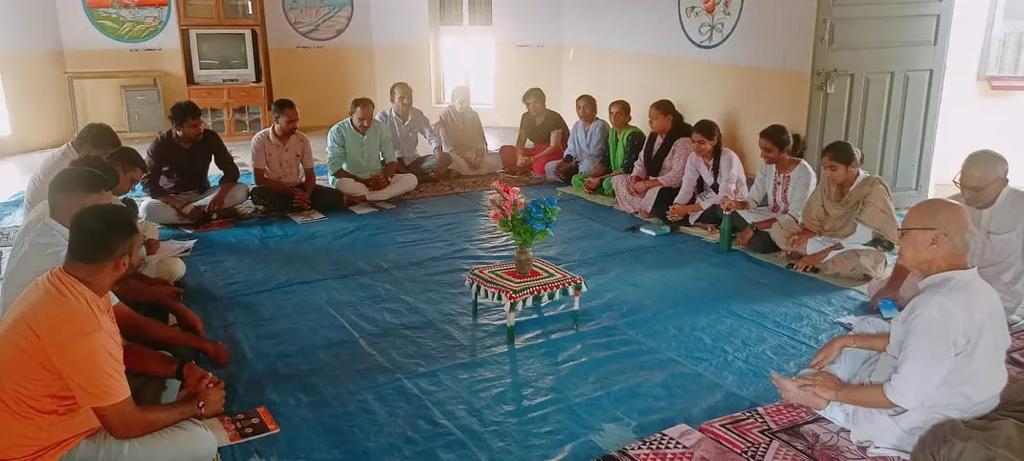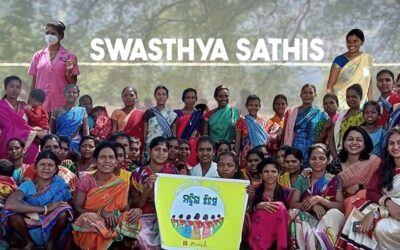Early in the morning, all the residents of Gram Swaraj Sangh (GSS) campus and the students of the school assembled at the ground. The gardening hoes and brooms were put in line. All of us divided ourselves into groups and self-assigned the tasks. This was how we started the celebrations of the birthday of the father of our nation – Mahatma Gandhi, also known as Gandhi Jayanti.
GSS believes and works on the principles of Gandhian Philosophy. Everyone starts their day by doing Shramdaan. As Gandhi believed, everyone should do their work on their own as there is no work whose value is lesser or more. This also helps a person to be self-dependent.
We started the celebrations on 1st October itself. The first activity we did was watching a movie. We understood Gandhiji’s struggle for democracy through that movie. At the end of it, the head of GSS, Ramesh bhai shared his views on the movie. Next morning, we began with Shramdaan. All the groups had different tasks like watering trees, removing waste plants, cleaning the roads, separating the biodegradable and non-biodegradable waste etc.
After an hour-long recess, all of us gathered in the param samiti (prayer hall). The students sang melodious bhajans and gave speeches on Gandhiji. These were followed by a talk by Ramesh bhai. He shared the life story of Gandhiji and told us few inspirational incidents of his life. In the evening, we had a feast.
Book Reading Session
We started a new activity on 2nd October. All the campus members got a book. We read it and shared insights about it in sessions that are scheduled for the 15th and 30th of every month. I finished my book in time and was looking forward to sharing my thoughts. This was a very new learning experience for me as all of us planned and worked together. This also helped me to know more about how Gandhiji’s principles are put into action in the organisation. I’m also excited and very interested to understand and learn more and put into action in my life whichever feasible.

The first reading session was held after 15 days of the birthday celebrations. During these sessions, everyone gathers at a common place in our campus to share our thoughts on the book: what we’ve learned, what inspired us most, and any aspects we found challenging or didn’t understand. This sharing allows for discussions to enhance our comprehension. Additionally, we also summarized our respective books for everyone.
This wasn’t merely a session but a valuable opportunity for everyone in our campus to gain a deeper understanding of Gandhi’s life (as we believe and work on Gandhian philosophy). We’ve had limited exposure to understand Gandhi during our school or college days, but attending these sessions brings more depth. In the first month, that is, in October, I also got a book: “Gandhi Faces the Storm” by Gene Sharp. This book was published in 1961 which covers Mahatma Gandhi’s life from 1946 until his death. Last two years of his life.
My Understanding
This book doesn’t explain about Gandhi’s childhood, family, or educational background. Instead, it focuses only on the last two years of his life. These were difficult years for him, which was compared to a storm in this book, during which he suffered immense inner disturbance. Gandhi struggled for his nation against his own people, advocating the strength of non-violence. He devoted extensive efforts to marches, fasting for Hindu-Muslim unity, among other challenges, all of which were incredibly difficult for him.
His belief in non-violence was resolute. He once stated that India, a nation that had attained its freedom without using arms (the army), should maintain its freedom without resorting to arms as well.
“Would India go the way of violence, or the way of Gandhi?”
This was the pivotal question of that time. It was an era marked by the use of atom bombs. Yet, Gandhi persevered with his belief in love and non-violence. He believed that non-violence was a path of truth for the courageous, not the cowardly. The power of non-violence could even move mountains.
While reading this book, the image that comes to my mind is of present India—a similar religious conflict between Hindus and Muslims. People are ready to harm each other and the prevalence of hatred is visible. The only difference I observed was the absence of a figure like Gandhi, in whom people could place their trust—a leader who could fight for the nation and guide them on the path of non-violence.
Numerous questions surfaced on my mind. Are we not progressing towards violence? Aren’t we losing our humanity? Are we not fostering hatred toward other religions?
In his last years while witnessing this hate and conflict among people and their choice of violence over non-violence, Gandhi once said, “This is not the India I dreamed of.” The India of his dreams embodies non-violence, brotherhood, and abundant love—a country where people coexist peacefully and harmoniously.
This book not only enriched my knowledge about Gandhi’s advocacy for non-violence but also prompted me to contemplate more about my country—understanding both past and present-day India. I am eagerly waiting for more such sessions and books that will further help me develop my understanding about Gandhi.




0 Comments